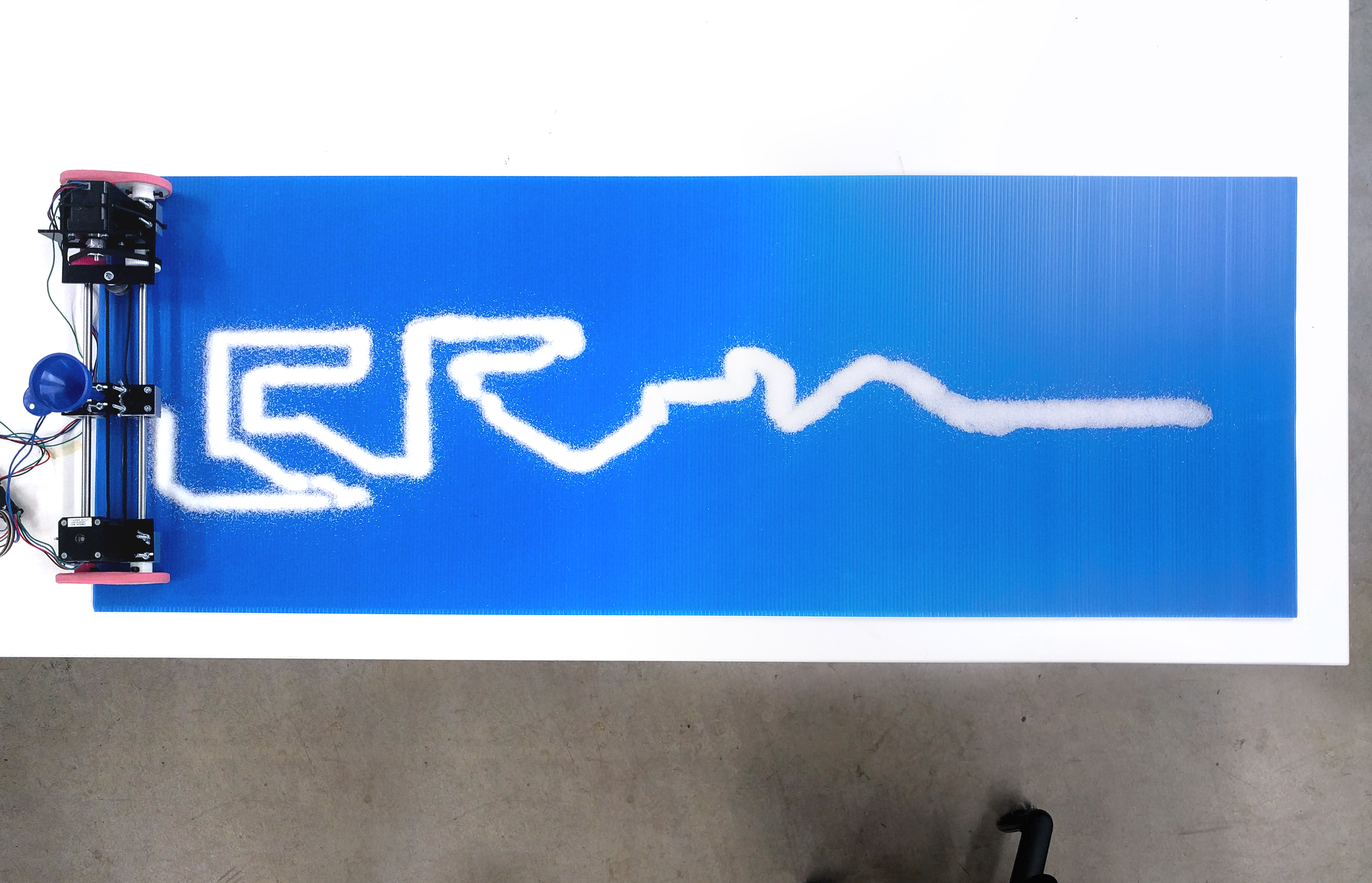Mandala Plotter
This project is an attempt at building an ‘infinite Y-axis’, modular plotter that works with granular/powdery materials, such as sand. It advantageously uses wheels instead of a second set of rails, allowing it to run until it hits the next wall. The shaft moves along the X-axis rails, that are also the Y-axis’ wheels axles.
produced by: Julien Mercier
Strategy, Habitat and Further Development
My underlying strategy draws in the artistic tradition of “creating tools” and as such this project is meant to be seen as a means rather than an end in itself. My intention is to shorten the digital making toolchain between the artist and his outputs. My interest in CNC systems goes back many years, and despite their increasingly widespread use at all levels of artistic practice, it has not yet been exhausted, from where I stand. Research in rapid prototyping emerges every day, and using such devices with new materials (two-components, time reactive, etc.) might lead to entirely new applications.
My habitat signifies my current limits. Expanding my perspectives compares to expanding my habitat. The more space I can create, the more potential my outputs will have. While this current prototype is limited in size and reach, the aim is to develop it further into a fast-printing device for the making of large, ‘impermanent’ artworks on the floor, inspired by the spiritual and ritual art of mandala making. I’ve long wanted to start building a modular system from scratch, that I could keep developing as my needs evolve. While this previously seemed like a bottomless chasm, I was able to make a substantial leap over this term, thanks to the sum of in-class tutoring and an important online community of makers, who share their experience and knowledge. The next technical steps will be to tame the GRBL library (possibly Marvin too), calibrate the steppers (steps, limits, keep track of position…), and use all the functions of the shield (limits, E-stop, cooler…) in order to develop into a 'grown-up', fully functioning CNC system.
The future artistic endeavours I’d like to pursue will discuss the utopian promises of new technologies as well as the way they induce new rituals that might substitute various spiritual traditions. Indeed, mandalas’ sacred nature lies in the time they take to realize, in their impermanence, and as such express the transient nature of life. In this context, trying to replace the human hand with a machine can be seen as sacrilege, but may also provide an opportunity for introspection. What place do we really want to give to technology? What are the limits we are not ready to exceed, for the time being? Techno-global capitalism does not spontaneously make room for such questions, and they all too often answers themselves at the users’ own expense.
View and download pdf of the project: http://journal.julienmercier.in/mandalaPlotter.pdf
Source Code
View and download the code on GitHub: https://github.com/djebel-amila/mandalaPlotter
References
— I’ve used the Arduino CNC shield, built and sold by Protoneer: https://blog.protoneer.co.nz/arduino-cnc-shield/
— I’ve used the “Accelstepper and Multistepper” library by Mike Mc Cauley, available here: http://www.airspayce.com/mikem/arduino/AccelStepper/ and here: https://github.com/vberkaltun/MultiStepper
— I’ve followed and adapted this tutorial hosted on brainy-bits.com in order to add analog joystick control: https://www.brainy-bits.com/arduino-joystick-tutorial/
— I found additional help and information on how to link the joystick read to the steppers (adapting servos to steppers) from this page hosted on maker.pro: https://maker.pro/arduino/tutorial/how-to-control-servo-motors-with-an-arduino-and-joystick
— I’ve followed this tutorial from bc-robotics and built the circuit, in order to control and power the solenoid I use in my printing shaft. I built and soldered the matching circuit: https://www.bc-robotics.com/tutorials/controlling-a-solenoid-valve-with-arduino/
— On the—mostly mental—spaces left to colonize: 24/7: Late Capitalism and the Ends of Sleep. Jonathan Crary. London ; New York : Verso, 2013.
— “Hektor”, “Rita” and “Viktor”, Jurg Lehni, 2002, http://juerglehni.com/works/hektor
— “Machines that Make”, MIT, http://mtm.cba.mit.edu/
— “Rapid Liquid Printing”, MIT’s Self-Assembly Lab, Skylar Tibbits/Christophe Guberan, https://selfassemblylab.mit.edu/rapid-liquid-printing/ & http://www.christopheguberan.ch/rapid-liquid-printing/

































































